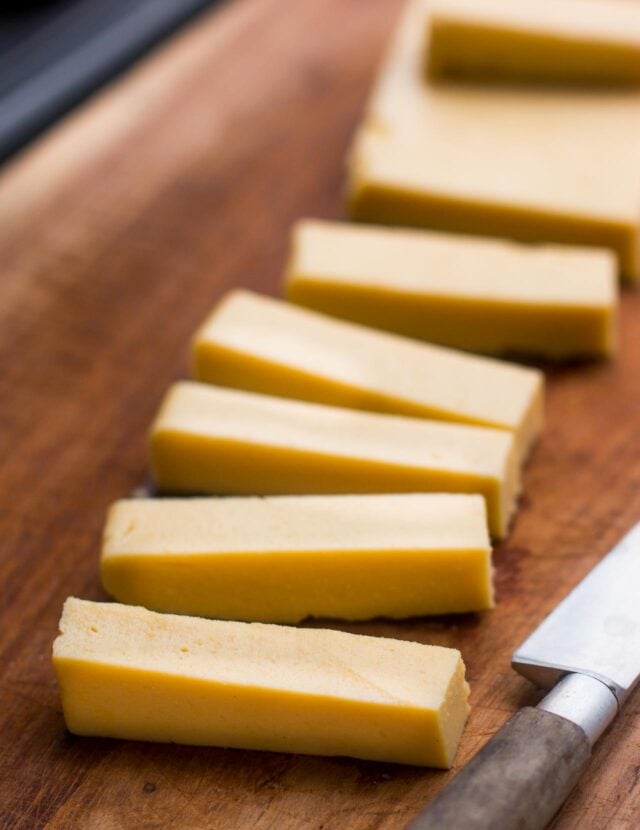Panisse recipe


Making the batter for panisses is similar to making polenta, and just as easy. I don’t know if there is any “official” shape they’re supposed to be. In the south of France, they sometimes fashion the panisse mixture into thick logs with molds, then slice them into rounds (or half-rounds) for frying. In Jacques Médecin’s iconic book, Cuisine Niçoise, he calls for the cook to oil a dozen small saucers and use those to mold the panisse mixture, which is later cut into baton-like shapes, which are more irregular (but kinda fun) due to the circular saucers.
My sous-tasse (saucer) game isn’t as strong as his – I only have three, and I don’t think the dark blue one counts – so I use a 9-inch (23cm) square cake pan, which does the job nicely. If you do go to Nice or Marseille, you can still sometimes find them sold in disks with the signature circular marks of the indentations of saucers in shops, ready to fry. To be authentic, they should only be made of chickpea flour (like their cousin, socca), although I horrified a Niçoise friend when I told her one packet I saw at an épicerie (food shop) near her town listed wheat flour as an ingredient.
Deep-frying is generally a recipe deal-breaker for me. Any recipe that says, “Heat 4 quarts of oil in a pot…”, I turn the page or click away as fast as I can. So I prepare a nice bain of olive oil, a bath if you will, that’s deep enough to give them a nice golden exterior and keep them from sticking, and use that rather than a bottle of olive oil. It works perfectly.
As mentioned, when I first wrote this post, chickpea flour was difficult to find and was most easily obtained by a trip to a shop that sold ingredients for Indian or Middle Eastern cooking (where it’s called gram or besan.) But some of it is quite coarse and sometimes it’s made from roasted chickpeas, neither of which you want here.
With a rise and interest in gluten-free baking, chickpea flour (also called garbanzo flour) is easy to find at natural food stores and I get mine in Paris at Biocoop or Naturalia, where it’s labeled farine de pois chiche and you can find it in Italian food shops labeled farina di ceci too. You want to use unroasted chickpea flour that’s finely milled, as shown below. You can also get it via mail order from Bob’s Red Mill and Amazon, and for DIYers, there are recipes for making it yourself.
Panisses
- 2 1/4 cups (250g) chickpea flour
- 1 teaspoon coarse salt
- 2 teaspoons olive oil
- 1 quart (a scant liter) water
- olive oil, for frying
- coarse salt and freshly-cracked pepper, for serving
- Lightly oil a 9-inch (23 cm) square cake pan, or similar sized vessel.
- Pour the chickpea flour in a medium saucepan along with the salt and olive oil. Add half of the water and stir with a sturdy whisk until the mixture is smooth. Whisk in the rest of the water.
- Bring the mixture to a boil over high heat, stirring frequently with the whisk until it just begins to boil and thicken. Reduce the heat to low-to-medium, and continue to cook, stirring with the whisk (or a wooden spoon or spatula) until the mixture thickens and holds its shape, and pulls away from the side of the pan, about 10 minutes. It should resemble stiff, sticky mashed potatoes.
- Immediately scrape the mixture into the oiled pan, smooth the top, and let cool. It may be difficult to get the top smooth, so do it as quickly as you can. You can use a offset spatula dipped in water to help smooth the top, and once you've smoothed it as best as you can, fold a kitchen towel on the counter and drop the pan a few times on the towel to help smooth it out even further. Let cool completely at room temperature.
- To fry the panisses, unmold the solidified mixture on a cutting board and slice into three rectangles. Then use a knife to cut 3/4-inch (2cm) batons.
- In a heavy-duty skillet, heat 1/3 to 1/2 inch (1,5 cm) of olive oil. Don't be too parsimonious with the olive oil. When shimmering hot, fry the panisses in batches, not crowding them in the pan. Once the bottom is nicely browned and crisp on the bottom, turn with tongs, frying the panisses, turning them once each side is browned, until they're deep golden brown on each side. They'll take at least 5 minutes to fry them and the first batch will cook slower than subsequent batches.
- Remove the panisses from the pan and drain on paper towels or on a brown paper bag, sprinkling them very generously with salt and pepper. Don’t be stingy with either. Continue frying the rest of the panisses, heating more oil in the pan as needed.























